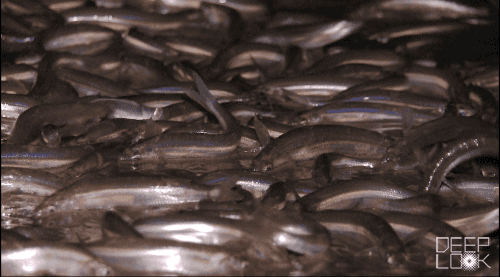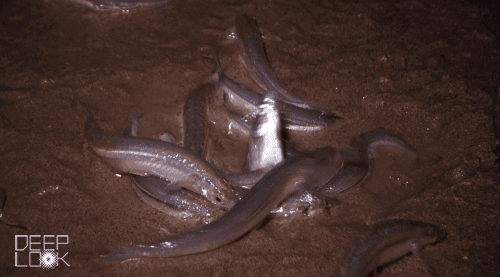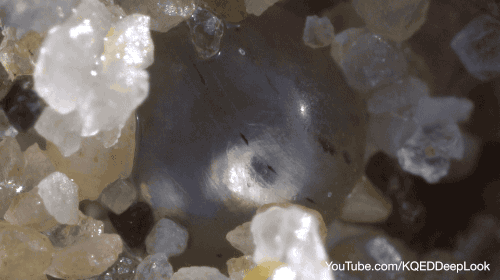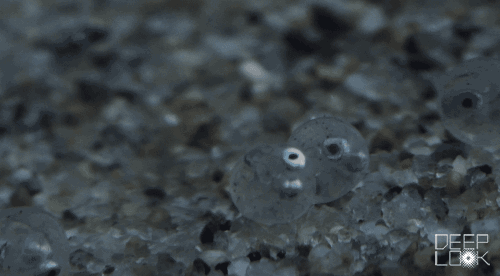These Fish Are All About Sex on the Beach | Deep Look
With summer just around the corner, Southern California beaches are ready to welcome the yearly arrival of some very unique and amorous guests. That’s right, the grunion are running!
California grunion are fish that spend their lives in the ocean. But when the tides are at their highest during spring and summer, grunion make a trip up onto beaches to mate and lay eggs.
Grunion mate on beaches throughout Southern California and down into Mexico. The grunion runs are especially popular in coastal communities like Santa Barbara and San Diego.
During warm summer nights, crowds emerge to witness the grunion run. Some are there just to watch. Others scramble in the darkness to catch the fish and bring them home for a date with the grill or frying pan.
Grunion ride in on the biggest waves, wiggling and flopping to get as far up onto the sand as possible.

“They’re not particularly agile on land but they’re able to do what they need to do,” said Karen Martin, a biology professor at Pepperdine University.
Martin said she doesn’t get much sleep this time of year because California grunion typically run at night. Instead she can be found leading groups of students and researchers out to the coast where they use night-vision scopes and headlamps to search for the fish.
By tracking the tides, Martin is able to estimate the time when grunion are most likely to run. But the exact timing and locations are anyone’s guess.
“You have to know where to look,” she said.
“It’s not like they run across the entire beach, usually it’s just one little area where you might be able to find them.”
Female grunion use their tails to burrow down into the loose wet sand until they are buried up to their gills. That’s when they lay their translucent orange-yolked eggs. The eggs are tiny— each one a little smaller than a pea.
The male grunion do their best to join up with the females and that’s no easy feat.

Grunion don’t appear particularly well adapted to getting around on the damp sand. Instead they bend their bodies and hurl themselves into the dark in search of mates.
When they do meet up, the males curl their bodies around the females and fertilize the eggs.

“They’re not out very long,” Martin said. “But they’re not breathing air. They won’t survive very long like that, but when they’re out they don’t appear to be stressed out and panicking.”
When the deed is done, the grunion wiggle back out and catch the next big wave home.
The whole undertaking is a sight to behold and prompts the question of why a fish would want to risk coming out on land just to leave their next generation stranded in the dry sand.
“I guess they just do it for the kids’ sake,” Martin said. “They get to develop in a protected area.”
The ocean is full of predators who would like to gobble up a tasty fish egg. The grunion eggs tend to be safer up on the beach if they can make it there without raising the attention of predators like birds and raccoons.
Each egg is encased in a thick clear layer called a chorion that serves to protect them from damage while allowing oxygen through to the developing fish.
“If you touch them they almost feel like they’re made of plastic,” Martin said.

The chorion makes the eggs tough enough to survive being buried under the sand and keeps them from drying out while they develop.
And that sand may not be as dry as it seems.
“The surface might be totally dry but if you dig down a few inches where the eggs are then it’s still damp,” Martin said.
The baby grunion wait for the next cycle of high tides to take them back out to sea. That typically means a two-week wait. But if that set of high tides turns out to be a dud, the grunion eggs can stay put for an extra two weeks to catch the following cycle.
When the high tides do return, the grunion get swept out by the waves.
The cold seawater is the signal to hatch.

Spurred on by the agitation of getting bounced around in the waves, the grunion come bursting out of their chorions and swim off to live their lives in the sea.
The mating runs were first described in the early part of the 20th century, but the timing wasn’t linked to the tides until the 1940s. By then it was also becoming clear that people were catching grunion faster than they could be replaced.
To protect the grunion, the fishing season closes every year during the peak of the expected spawning period. During the open season there is no take limit but grunion can only be caught with hands without the use of nets or traps.
In addition to their dangerous mating strategy, grunion populations also contend with loss of sandy beach habitats and coastal pollution.
“These animals depend on their beaches,” said Martin. “The experience of watching them come surfing in on the waves… it goes along with our whole California thing.”
For more info about grunion head over to http://www.grunion.org/
